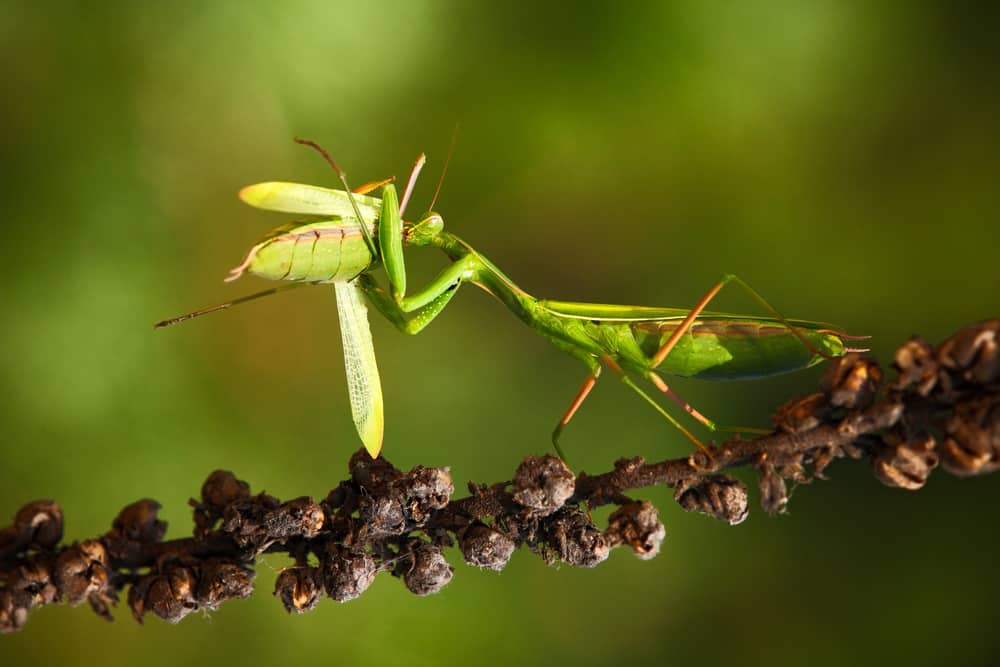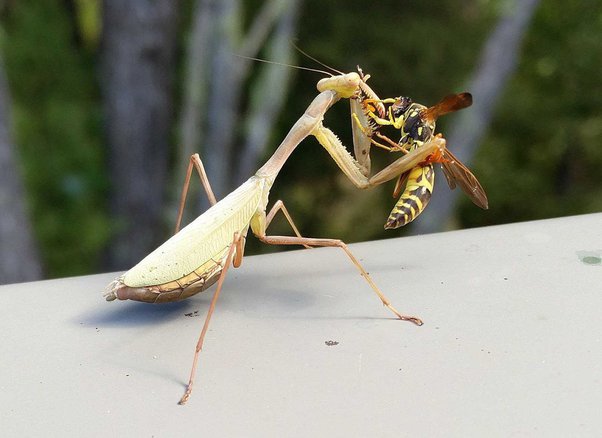Table of Contents
ToggleIntroduction

The unique appearance and fascinating hunting activities of praying mantises have piqued the curiosity of nature lovers and scientists. Praying mantises are well-known for their exciting look and fun hunting techniques. The question, “What do praying mantis eat?”This book delves deeply into praying mantises’ diet, hunting techniques, and ecological function.
Overview Of Praying Mantis
Before delving into the specifics of their diet, let’s start with a brief introduction to praying mantises.
The Praying Mantis Family
Praying mantises belong to the Mantidae family, which is a part of the larger order Mantodea. Around 2,500 known species of mantises have been dispersed worldwide, with the majority found in tropical and subtropical regions.
Unique Physical Features
Praying mantises are easily recognizable due to their unique physical features. They have elongated bodies, large compound eyes, and powerful front legs modified for grasping prey. These front legs, often called “raptorial legs,” give mantises their characteristic praying posture.
Camouflage and Coloration
Mantises exhibit remarkable camouflage, which varies between species. Some mantises resemble leaves or branches, allowing them to blend seamlessly into their surroundings. Others may have bright colors to mimic toxic insects, deterring potential predators.
The Praying Mantis Diet
Praying mantises are carnivorous predators with a diverse diet that includes various small creatures. Their hunting skills and voracious appetite make them efficient insect hunters.
Insectivorous Diet
The primary diet of praying mantises consists of insects. They are known to prey on a wide range of insect species, including flies, mosquitoes, moths, butterflies, grasshoppers, crickets, and more. Mantises are opportunistic feeders and will capture whatever suitable prey comes within their reach.
Cannibalism
One intriguing aspect of mantis behavior is cannibalism, where more enormous female mantises occasionally consume smaller male mantises during or after mating. This phenomenon, while not universal, occurs in some mantis species, possibly as a survival strategy for the female.
Nectar and Supplemental Nutrition
In addition to insects, some mantis species supplement their diet with nectar. They may visit flowers to feed on nectar, which provides them with essential nutrients and energy. Nectar consumption is widespread among mantises that inhabit areas with limited prey availability.
Praying Mantis Hunting Strategies
Praying mantises are renowned for their hunting techniques, which are both stealthy and deadly. Their hunting strategies are a testament to their adaptability and efficiency as predators.
Ambush Predators
Praying mantises are ambush predators, patiently waiting for unsuspecting prey to come within striking distance. They often adopt a motionless posture, blending into their environment to avoid detection. When the game approaches, they strike with remarkable speed, using their raptorial legs to grasp and immobilize their victim.
Camouflage and Mimicry
Many mantis species employ camouflage and mimicry to deceive their prey. They resemble parts of plants or insects, luring their victims into a false sense of security. This disguise allows mantises to get close to their game without raising suspicion.
Stealth and Patience
Mantises are known for their patience. They may remain motionless for extended periods, waiting for the right moment to strike. This stillness, combined with their cryptic appearance, helps them avoid detection by prey and potential predators.
Lightning-Fast Strikes
When it’s time to strike, mantises execute lightning-fast movements. Their raptorial legs can close in a fraction of a second, trapping their prey before it can escape. This speed and precision are crucial to their hunting success.
The Ecological Role Of Praying Mantises
Praying mantises play essential roles in the ecosystems they inhabit, contributing to ecological balance and pest control.
Natural Pest Control
Natural pest control is one of the mantises’ most valuable ecological services. By preying on insects considered agricultural pests, mantises help reduce crop damage and minimize the need for chemical pesticides. It makes them valuable allies for farmers and gardeners.
Predators of Harmful Insects
Mantises are effective predators of insects like aphids, caterpillars, and flies, which can cause significant damage to plants and crops. Their presence in gardens and agricultural areas can help maintain healthy plant populations.
Maintaining Biodiversity
As generalist predators, mantises contribute to the diversity of prey species in their habitats. It helps prevent the dominance of any one insect species and maintains a more balanced ecosystem.
Praying Mantises In Captivity
Insect aficionados sometimes keep praying mantises as pets. Their health and well-being in captivity depend on careful management of their diet and care.
Diet in Captivity
In captivity, pets maintain a diet of live insects. Everyday prey includes fruit flies, crickets, houseflies, and other small insects. The prey size should be appropriate for the mantis’s age and size.
Nutritional Requirements
Proper nutrition is essential for the health of captive mantises. In addition to insects, it’s important to provide supplemental hydration through misting their enclosure and, in some cases, offering a small dish of water with a sponge.
Housing and Maintenance
A mantis enclosure must be big enough for the animal, have an appropriate substrate, and have places to hide. Maintaining a comfortable temperature and humidity level is crucial to their well-being. Consistent cleaning and upkeep are essential for keeping a healthy and pleasant environment.
Ethical Considerations
When keeping mantises as pets, it is crucial to consider their ethical implications. It is essential to practice responsible breeding and sourcing mantises to ensure these animals’ health and protect the native populations from potential harm.
Advantages Of Praying Mantises Eat

Natural Pest Control: Praying mantises are highly effective at hunting and consuming a variety of insect pests. They target insects like aphids, caterpillars, grasshoppers, and flies that can damage crops and ornamental plants. This natural pest control reduces the need for chemical pesticides, which can have harmful environmental and health effects.
Ecosystem Balance: Mantises play a role in maintaining the balance of insect populations in their ecosystems. By preying on various insects, they help prevent the dominance of any single species, contributing to a more diverse and stable ecosystem.
Reduced Crop Damage: In agricultural settings, mantises can help reduce crop damage caused by insect pests. It can lead to increased crop yields and reduced economic losses for farmers.
Decreased Reliance on Chemical Pesticides: The presence of mantises in gardens and agricultural fields can reduce the reliance on chemical pesticides, adversely affecting beneficial insects, soil health, and the environment. It, in turn, supports sustainable and eco-friendly farming practices.
Diverse Prey Range: Mantises are generalist predators that prey on various insects. Their adaptability to different prey species allows them to target a broad range of potential pests, making them versatile and valuable for pest management.
Biological Control: Praying mantises are an example of birth control in agriculture. Injecting chemicals into farms to control pest populations can help reduce accidental spills.
Education and Awareness: The presence of mantises in natural environments and gardens can foster education and awareness about the importance of insects and their roles in ecosystems. Observing mantises in action can be a valuable learning experience for children and adults.
Reduced Insect-Borne Diseases: By preying on flies and mosquitoes, mantises can indirectly help reduce the transmission of insect-borne diseases to humans and animals.
Research and Study: Praying mantises serve as subjects of scientific research, contributing to our understanding of insect behavior, biology, and ecology. They are frequently tested in predation, mimicry, and sensory perception experiments.
Pollination (in some cases): While mantises are primarily carnivorous, some species have noticed consuming nectar from flowers. In doing so, they may inadvertently facilitate pollination, although their role in pollination is not as significant as that of other insects like bees and butterflies.
Inspiration for Biomimicry: The hunting strategies and physical characteristics of mantises have inspired scientists and engineers to develop innovative technologies and robotics. For example, studying mantis vision systems has led to computer vision and robotics advancements.
Conclusion
Carnivorous insects known as Praying mantis have a varied diet of many rodents and other small animals. Their methods of predation, which include sneaking up on prey, imitating them, and striking with blinding speed, make them highly effective as hunters.
In addition to their essential role as natural pest controllers, praying mantises significantly preserve biodiversity. Captivity enthusiasts keep them as pets by providing live insects and carefully managing their care. In the wild, they are hunted and eaten by humans. In entomology, these fascinating insects continue to grab our imagination with their one-of-a-kind behaviors and adaptations, making them a subject of study and an object of admiration.







